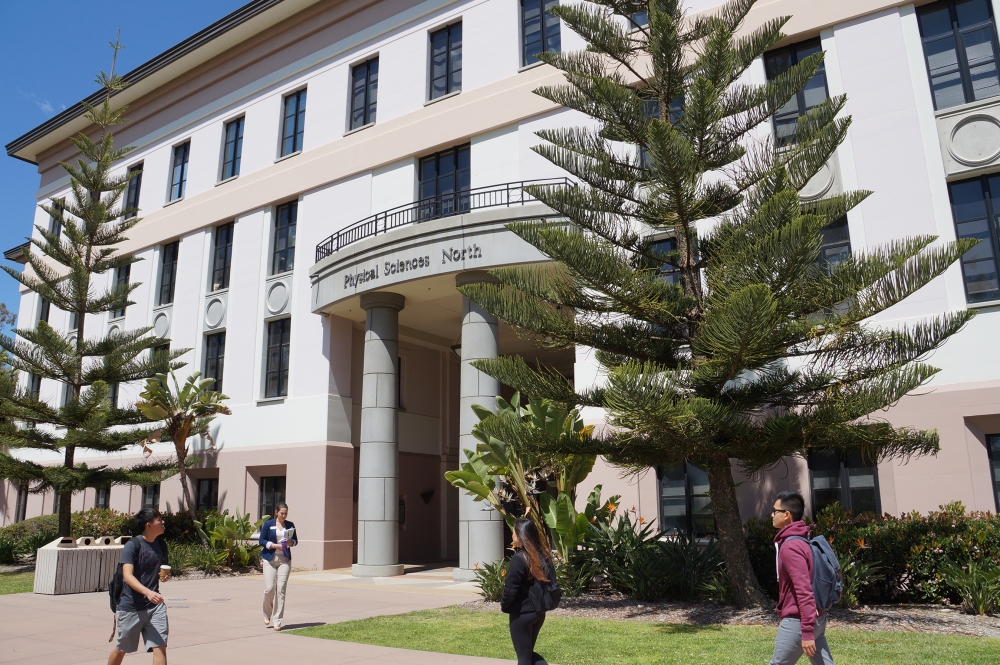
Reducing Energy Use

The University of California has set a goal of zero greenhouse gas emissions by 2025, and UC Santa Barbara has ramped up its sustainability efforts accordingly. The challenge, however, is to keep emissions down while the campus grows by 1 percent each year as projected in its Long Range Development Plan.
To help meet that challenge, four students at the campus’s Bren School of Environmental Science & Management developed a behavior-based pilot project designed to reduce energy consumption in three campus buildings: the Gevirtz Graduate School of Education (GGSE), the Social Sciences and Media Studies Building (SSMS) and Physical Sciences Building North (PSBN).
The Operational Effectiveness: Energy Management Initiative, as it’s titled, serves as the students’ master’s thesis and targets occupant behavior through an educational and strategic messaging campaign. It offers a financial incentive, rewarding departments with a financial payment worth 50 percent of their annual energy saving. The team will present its final results at 2:45 p.m. Friday, April 24, at the Fess Parker DoubleTree Resort hotel in downtown Santa Barbara. The event, which features the Master of Environmental Science and Management Class of 2015 Final Presentations, is open to the public and begins at 1:30 p.m. Presentations will be followed by a poster session and reception at 5:30 p.m.
While UC Santa Barbara benefits from many energy-efficiency projects that improve building performance, none promotes behavioral change. “Currently, there is a disconnect between building occupants on campus and their electricity use,” said team member Stephanie Harris. “This is largely because users don’t have to pay for their energy consumption and generally don’t know how much energy they are using.”
Prior to the rollout of the pilot program and again during it, the team conducted energy surveys and walkthroughs in three buildings. The before-and-after comparison showed increased energy-efficient behaviors in key areas such as turning lights off in unoccupied rooms, turning lights off in rooms with sufficient ambient light, using computer power-saving settings and not using space heaters.
The pilot project’s strategic messaging, which helped occupants understand their energy use, produced an average 4.5 percent reduction in overall energy use in the pilot buildings. The team measured these reductions in two ways: by comparing monthly energy use during the pilot program to a baseline calculated from the average of the prior two years energy use for that month; and by running a linear regression to account for factors such as daylight, temperature, weekends, holidays and breaks to model daily energy use in the buildings.
“Given the average 4.5 percent reduction we saw in our pilot program, a campuswide program would have a net present value of about $500,000 and would reduce CO2 emissions associated with energy use by about 700 tonnes of CO2 annually,” said grad student Lisa Campbell. “That’s equivalent to removing 134 cars from the road.”
Results show that from November 2014 to March 2015, average energy reductions were 6 percent in GGSE, 4.8 percent in SSMS and 2.6 percent in PSBN. GGSE and SSMS are LEED Silver certified by the U.S. Green Building Council so they are more energy-efficient than PSBN, where the installation of circuit submetering was not possible due to the building’s age. In order to get a better understanding of energy use in PSBN, the group analyzed how consumption changed throughout the day and found that heating, ventilating and air conditioning (HVAC) used the vast majority of electricity, accounting for roughly 80 percent of the peak energy demand.
While the HVAC system with respect to occupant behavior could not be affected, the team identified a couple of ways to optimize existing building settings to reduce the amount of time the HVAC system ran at full capacity. For example, they are working to increase the nightly setback and recalibrate the fume hood ventilation flow rates.
“We’ve proved through our pilot that a behavioral-based energy-efficiency program can significantly reduce energy consumption on campus,” said Ian Creelman, another member of the group. “That would have significant savings in both reducing the utility costs to the university and also lowering associated carbon emission.”
The group’s report also included a cost-benefit analysis of a campuswide program, which indicated that energy use would need to be reduced by only 2.5 percent to accrue financial benefits. Based on the successes of the pilot program, the Bren team is presenting Utility and Energy Services with a timeline and framework that can be used to implement a behavior-based energy conservation program campuswide.
“Changing occupant interactions within buildings on campus to be more energy-efficient is an effective way to decrease overall campus energy use and can reduce campuswide energy consumption by up to 15 percent,” said grad student and team member Brett Olson.
“This is an excellent project,” said Marc Fisher, vice chancellor for administrative services. “It parallels programs at Stanford and UC Berkeley that have produced tangible environmental and fiscal results. We are very excited to review the efforts of our Bren students’ pilot to understand how it might be expanded at UCSB. I want to personally thank them for their diligence and professionalism. Our students make incredible partners.”



